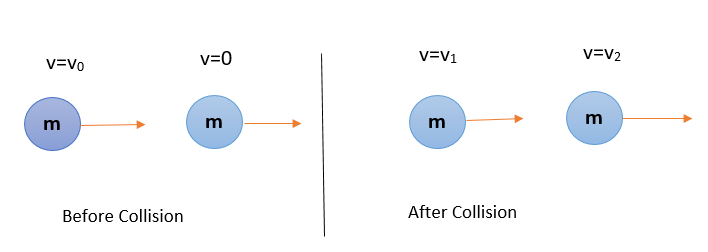
Answer
447.9k+ views
Hint: As the collision is collinear the conservation of energy and the linear momentum will hold good. So first use the conservation of energy to get a relation between the velocities before collision and velocities after collision. And then use conservation of momentum to get another relation between the velocities before collision and velocities after collision. After that you can calculate the difference between the velocities of the masses after the collision to the relative velocity between the masses.
Formulas used:
The kinetic energy of a particle moving with velocity $v$ and mass $m$ is given by
$K.E=\dfrac{1}{2}m{{v}^{2}}$.
The linear momentum of a particle moving with velocity $v$ and mass $m$ is given by
$P=mv$
Complete step by step answer:

The collision is collinear and the objects are identical. One object is at rest and another is moving with velocity ${{v}_{0}}$ . After the collision the velocities of the two objects are ${{v}_{1}}$ and ${{v}_{2}}$ .
According to the question the final total kinetic of energy is $50%$ greater than the original kinetic energy.
The total Kinetic energy before the collision is $\dfrac{1}{2}mv_{0}^{2}$ and the kinetic energies of the two particles after the collision is $\dfrac{1}{2}mv_{1}^{2}$ and $\dfrac{1}{2}mv_{2}^{2}$.
But the final total kinetic of energy is $50%$ greater than the original kinetic energy. So the $50%$ of the original kinetic energy is \[\dfrac{1}{2}\left( \dfrac{1}{2}mv_{0}^{2} \right)=\dfrac{1}{4}mv_{0}^{2}\] . So according to conservation of kinetic energy
\[\begin{align}
& \dfrac{1}{2}mv_{0}^{2}+\dfrac{1}{4}mv_{0}^{2}=\dfrac{1}{2}mv_{1}^{2}+\dfrac{1}{2}mv_{2}^{2} \\
& \Rightarrow \dfrac{3}{4}mv_{0}^{2}=\dfrac{1}{2}mv_{1}^{2}+\dfrac{1}{2}mv_{2}^{2} \\
& \Rightarrow \dfrac{3}{2}v_{0}^{2}=v_{1}^{2}+v_{2}^{2} \\
& \Rightarrow v_{1}^{2}+v_{2}^{2}=\dfrac{3}{2}v_{0}^{2} \\
\end{align}\]
The momentum before the collision is $m{{v}_{0}}$ and zero. And the momentum of the objects after the collision is $m{{v}_{1}}$and $m{{v}_{2}}$.
Applying the conservation of momentum
\[\begin{align}
& m{{v}_{0}}=m{{v}_{1}}+m{{v}_{2}} \\
& \Rightarrow {{v}_{0}}={{v}_{1}}+{{v}_{2}} \\
& \Rightarrow v_{0}^{2}={{\left( {{v}_{1}}+{{v}_{2}} \right)}^{2}}=v_{1}^{2}+v_{2}^{2}+2{{v}_{1}}{{v}_{2}} \\
& \Rightarrow v_{0}^{2}=\dfrac{3}{2}v_{0}^{2}+2{{v}_{1}}{{v}_{2}}\left( \because v_{1}^{2}+v_{2}^{2}=\dfrac{3}{2}v_{0}^{2} \right) \\
& \Rightarrow 2{{v}_{1}}{{v}_{2}}=v_{0}^{2}-\dfrac{3}{2}v_{0}^{2}=-\dfrac{1}{2}v_{0}^{2} \\
\end{align}\]
Now we calculate the relative velocity of the objects after the collision. i.e. ${{v}_{1}}-{{v}_{2}}$ .
So, ${{\left( {{v}_{1}}-{{v}_{2}} \right)}^{2}}=v_{1}^{2}+v_{2}^{2}-2{{v}_{1}}{{v}_{2}}$
But \[v_{1}^{2}+v_{2}^{2}=\dfrac{3}{2}v_{0}^{2}\] and \[2{{v}_{1}}{{v}_{2}}=-\dfrac{1}{2}v_{0}^{2}\] , now
$\begin{align}
& {{\left( {{v}_{1}}-{{v}_{2}} \right)}^{2}}=v_{1}^{2}+v_{2}^{2}-2{{v}_{1}}{{v}_{2}}=\dfrac{3}{2}v_{0}^{2}-\left( -\dfrac{1}{2}v_{0}^{2} \right)=\dfrac{3}{2}v_{0}^{2}+\dfrac{1}{2}v_{0}^{2} \\
& \Rightarrow {{\left( {{v}_{1}}-{{v}_{2}} \right)}^{2}}=\dfrac{4}{2}v_{0}^{2}=2v_{0}^{2} \\
& \Rightarrow {{v}_{1}}-{{v}_{2}}=\sqrt{2v_{0}^{2}}=\sqrt{2}{{v}_{0}} \\
\end{align}$
Which is the relative velocity after the collision
So the correct option is B.
Note:
The law of conservation of energy states that during elastic collisions the total energy before the collision is equal to the total energy after the collision. It is valid for only elastic collision. Because in elastic collisions no energy is absorbed during the collision. The law of conservation of momentum states that the momentum before the collision is equal to the momentum after the collision.
Formulas used:
The kinetic energy of a particle moving with velocity $v$ and mass $m$ is given by
$K.E=\dfrac{1}{2}m{{v}^{2}}$.
The linear momentum of a particle moving with velocity $v$ and mass $m$ is given by
$P=mv$
Complete step by step answer:

The collision is collinear and the objects are identical. One object is at rest and another is moving with velocity ${{v}_{0}}$ . After the collision the velocities of the two objects are ${{v}_{1}}$ and ${{v}_{2}}$ .
According to the question the final total kinetic of energy is $50%$ greater than the original kinetic energy.
The total Kinetic energy before the collision is $\dfrac{1}{2}mv_{0}^{2}$ and the kinetic energies of the two particles after the collision is $\dfrac{1}{2}mv_{1}^{2}$ and $\dfrac{1}{2}mv_{2}^{2}$.
But the final total kinetic of energy is $50%$ greater than the original kinetic energy. So the $50%$ of the original kinetic energy is \[\dfrac{1}{2}\left( \dfrac{1}{2}mv_{0}^{2} \right)=\dfrac{1}{4}mv_{0}^{2}\] . So according to conservation of kinetic energy
\[\begin{align}
& \dfrac{1}{2}mv_{0}^{2}+\dfrac{1}{4}mv_{0}^{2}=\dfrac{1}{2}mv_{1}^{2}+\dfrac{1}{2}mv_{2}^{2} \\
& \Rightarrow \dfrac{3}{4}mv_{0}^{2}=\dfrac{1}{2}mv_{1}^{2}+\dfrac{1}{2}mv_{2}^{2} \\
& \Rightarrow \dfrac{3}{2}v_{0}^{2}=v_{1}^{2}+v_{2}^{2} \\
& \Rightarrow v_{1}^{2}+v_{2}^{2}=\dfrac{3}{2}v_{0}^{2} \\
\end{align}\]
The momentum before the collision is $m{{v}_{0}}$ and zero. And the momentum of the objects after the collision is $m{{v}_{1}}$and $m{{v}_{2}}$.
Applying the conservation of momentum
\[\begin{align}
& m{{v}_{0}}=m{{v}_{1}}+m{{v}_{2}} \\
& \Rightarrow {{v}_{0}}={{v}_{1}}+{{v}_{2}} \\
& \Rightarrow v_{0}^{2}={{\left( {{v}_{1}}+{{v}_{2}} \right)}^{2}}=v_{1}^{2}+v_{2}^{2}+2{{v}_{1}}{{v}_{2}} \\
& \Rightarrow v_{0}^{2}=\dfrac{3}{2}v_{0}^{2}+2{{v}_{1}}{{v}_{2}}\left( \because v_{1}^{2}+v_{2}^{2}=\dfrac{3}{2}v_{0}^{2} \right) \\
& \Rightarrow 2{{v}_{1}}{{v}_{2}}=v_{0}^{2}-\dfrac{3}{2}v_{0}^{2}=-\dfrac{1}{2}v_{0}^{2} \\
\end{align}\]
Now we calculate the relative velocity of the objects after the collision. i.e. ${{v}_{1}}-{{v}_{2}}$ .
So, ${{\left( {{v}_{1}}-{{v}_{2}} \right)}^{2}}=v_{1}^{2}+v_{2}^{2}-2{{v}_{1}}{{v}_{2}}$
But \[v_{1}^{2}+v_{2}^{2}=\dfrac{3}{2}v_{0}^{2}\] and \[2{{v}_{1}}{{v}_{2}}=-\dfrac{1}{2}v_{0}^{2}\] , now
$\begin{align}
& {{\left( {{v}_{1}}-{{v}_{2}} \right)}^{2}}=v_{1}^{2}+v_{2}^{2}-2{{v}_{1}}{{v}_{2}}=\dfrac{3}{2}v_{0}^{2}-\left( -\dfrac{1}{2}v_{0}^{2} \right)=\dfrac{3}{2}v_{0}^{2}+\dfrac{1}{2}v_{0}^{2} \\
& \Rightarrow {{\left( {{v}_{1}}-{{v}_{2}} \right)}^{2}}=\dfrac{4}{2}v_{0}^{2}=2v_{0}^{2} \\
& \Rightarrow {{v}_{1}}-{{v}_{2}}=\sqrt{2v_{0}^{2}}=\sqrt{2}{{v}_{0}} \\
\end{align}$
Which is the relative velocity after the collision
So the correct option is B.
Note:
The law of conservation of energy states that during elastic collisions the total energy before the collision is equal to the total energy after the collision. It is valid for only elastic collision. Because in elastic collisions no energy is absorbed during the collision. The law of conservation of momentum states that the momentum before the collision is equal to the momentum after the collision.
Recently Updated Pages
Who among the following was the religious guru of class 7 social science CBSE

what is the correct chronological order of the following class 10 social science CBSE

Which of the following was not the actual cause for class 10 social science CBSE

Which of the following statements is not correct A class 10 social science CBSE

Which of the following leaders was not present in the class 10 social science CBSE

Garampani Sanctuary is located at A Diphu Assam B Gangtok class 10 social science CBSE

Trending doubts
A rainbow has circular shape because A The earth is class 11 physics CBSE

Which are the Top 10 Largest Countries of the World?

How do you graph the function fx 4x class 9 maths CBSE

Fill the blanks with the suitable prepositions 1 The class 9 english CBSE

The Equation xxx + 2 is Satisfied when x is Equal to Class 10 Maths

Find the value of the expression given below sin 30circ class 11 maths CBSE

What is the length of the alimentary canal in human class 11 biology CBSE

Give 10 examples for herbs , shrubs , climbers , creepers

What is BLO What is the full form of BLO class 8 social science CBSE




